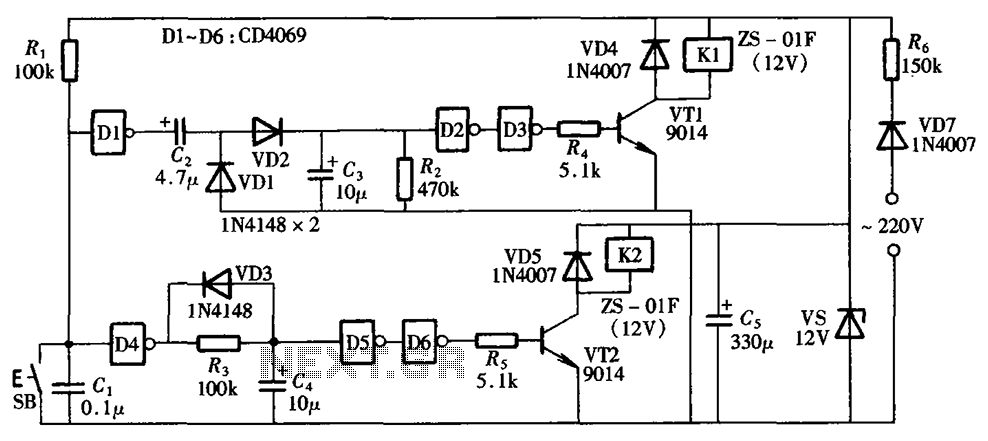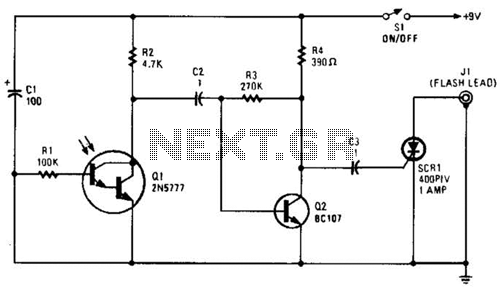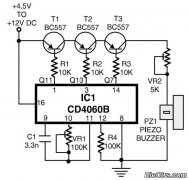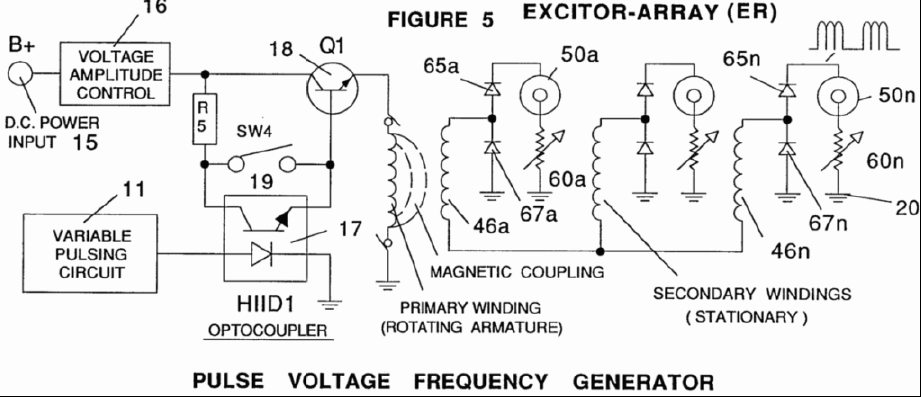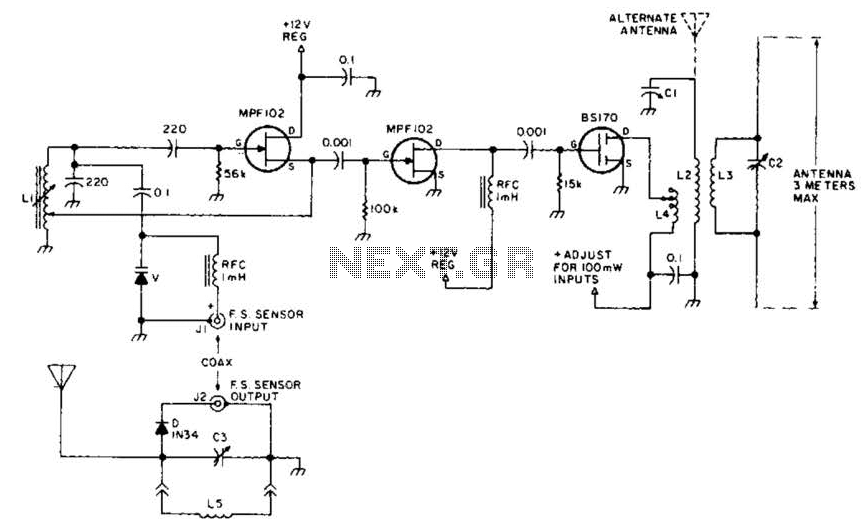
Audio Booster circuit
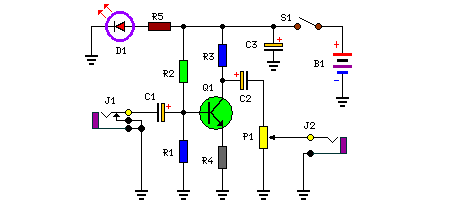
The amplifier's gain is nominally 20 dB. Its frequency response is primarily influenced by the values of a few components, mainly C1 and R1. The schematic diagram's component values yield a frequency response of ±3.0 dB from approximately 120 Hz to better than 20,000 Hz. The frequency response is relatively flat from around 170 Hz to well over 20,000 Hz; however, the low end shows some deviation from a flat frequency response. The roll-off at the low end is mainly determined by the value of capacitor C1, as the resistive value of R1 is fixed. If the value of C1 is altered to 0.1 pF, the corner frequency—where the low-end roll-off begins—drops to about 70 Hz. For an even deeper low-end roll-off, C1 can be changed to a 1.0 pF capacitor. If using an electrolytic capacitor, it is essential to connect it with the correct polarity, ensuring that the positive terminal is connected to the base terminal of Q1.
The described amplifier circuit is designed for a nominal gain of 20 dB, which is a common requirement in audio applications to ensure adequate signal amplification without distortion. The frequency response characteristics indicate that the circuit is well-suited for a wide range of audio frequencies, from the low bass to the high treble, with a specific focus on maintaining a flat response in the mid to high frequency range.
The critical components influencing the frequency response are C1 and R1. The capacitor C1 plays a pivotal role in defining the low-frequency roll-off characteristics of the amplifier. The fixed resistance of R1 provides a stable reference, but it is the capacitance value of C1 that dictates the behavior of the circuit at lower frequencies.
When C1 is set to 0.1 pF, the circuit's corner frequency is lowered to 70 Hz, which allows for better performance in reproducing lower frequencies. This adjustment is particularly beneficial in applications where bass response is crucial. If a further reduction in the corner frequency is desired, swapping C1 for a 1.0 pF capacitor can achieve an even greater low-end roll-off.
In the case of using an electrolytic capacitor for C1, it is vital to observe the correct polarity during installation. Connecting the capacitor in reverse can lead to failure or damage to the component and potentially affect the overall functionality of the amplifier. The positive terminal of the electrolytic capacitor must be connected to the base terminal of transistor Q1, ensuring that the circuit operates as intended.
Overall, this amplifier circuit is designed with specific attention to frequency response and component interaction, making it suitable for a variety of audio applications where both high fidelity and low-frequency performance are necessary.The amplifier`s gain is nominally 20 dB. Its frequency response is determined primarily by the value of just a few components-primarily C1 and R1. The values of the schematic diagram provide a response of ±3. 0 dB from about 120 Hz to better than 20, 000 Hz. Actually, the frequency response is ruler flat from about 170 Hz to well over 20, 000 Hz; it` s the low end that deviates from a flat frequency response. The low end`s roll-off is primarily a function of capacitor C1(since RI`s resistive value is fixed). If C1`s value is changed to 0. 1 pF, the low end`s comer frequency-the frequency at which the low-end roll-off starts-is reduced to about 70 Hz. If you need an even deeper low-end roll-off, change C1 to a 1. 0 pF capacitor; if it`s an electrolytic type, make certain that it`s installed into the circuit with the correct polarity, with the positive terminal connected to Q1`s base terminal.
🔗 External reference
The described amplifier circuit is designed for a nominal gain of 20 dB, which is a common requirement in audio applications to ensure adequate signal amplification without distortion. The frequency response characteristics indicate that the circuit is well-suited for a wide range of audio frequencies, from the low bass to the high treble, with a specific focus on maintaining a flat response in the mid to high frequency range.
The critical components influencing the frequency response are C1 and R1. The capacitor C1 plays a pivotal role in defining the low-frequency roll-off characteristics of the amplifier. The fixed resistance of R1 provides a stable reference, but it is the capacitance value of C1 that dictates the behavior of the circuit at lower frequencies.
When C1 is set to 0.1 pF, the circuit's corner frequency is lowered to 70 Hz, which allows for better performance in reproducing lower frequencies. This adjustment is particularly beneficial in applications where bass response is crucial. If a further reduction in the corner frequency is desired, swapping C1 for a 1.0 pF capacitor can achieve an even greater low-end roll-off.
In the case of using an electrolytic capacitor for C1, it is vital to observe the correct polarity during installation. Connecting the capacitor in reverse can lead to failure or damage to the component and potentially affect the overall functionality of the amplifier. The positive terminal of the electrolytic capacitor must be connected to the base terminal of transistor Q1, ensuring that the circuit operates as intended.
Overall, this amplifier circuit is designed with specific attention to frequency response and component interaction, making it suitable for a variety of audio applications where both high fidelity and low-frequency performance are necessary.The amplifier`s gain is nominally 20 dB. Its frequency response is determined primarily by the value of just a few components-primarily C1 and R1. The values of the schematic diagram provide a response of ±3. 0 dB from about 120 Hz to better than 20, 000 Hz. Actually, the frequency response is ruler flat from about 170 Hz to well over 20, 000 Hz; it` s the low end that deviates from a flat frequency response. The low end`s roll-off is primarily a function of capacitor C1(since RI`s resistive value is fixed). If C1`s value is changed to 0. 1 pF, the low end`s comer frequency-the frequency at which the low-end roll-off starts-is reduced to about 70 Hz. If you need an even deeper low-end roll-off, change C1 to a 1. 0 pF capacitor; if it`s an electrolytic type, make certain that it`s installed into the circuit with the correct polarity, with the positive terminal connected to Q1`s base terminal.
🔗 External reference

